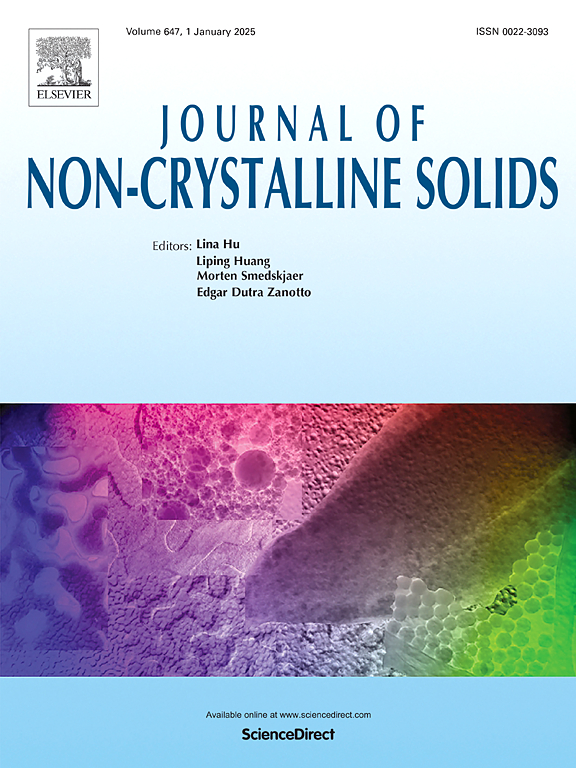Paradoxical hydrolytic degradation in GeO2-P2O5 glasses at high GeO2 content: A structural transition study
IF 3.5
3区 材料科学
Q1 MATERIALS SCIENCE, CERAMICS
引用次数: 0
Abstract
The GeO2-P2O5-based glass systems hold promise for advanced optical applications due to their high refractive index, excellent optical transparency, and tunable mechanical durability. Despite these advantages, phosphate-rich compositions face significant challenges from inherent hydrolytic instability caused by P-O bond cleavage under moisture. While moderate additions of GeO2 (≤ 50 mol %) have been shown to enhance structural stability and preserve optical performance by forming robust Ge-O-P and Ge-O-Ge linkages, an unexpected decline in hydrolytic durability is observed at higher GeO2 concentrations (> 55 mol %). This study systematically investigates this paradox across a compositional range of 45–75 mol % GeO2 using Fourier transform infrared spectroscopy (FTIR), scanning electron microscope (SEM), and X-ray photoelectron spectroscopy (XPS). Our findings reveal that increased GeO2 content induces a structural transition from six-coordinated to four-coordinated Ge, which diminishes Ge-O-P bonds and P-O-P long polymer chains. This shift results in poor hydrolytic stability due to enhanced water molecule interactions and terminal P-OH bond formation. By elucidating these mechanisms, this study provides critical insights into optimizing GeO2-P2O5 glass scanning electron microscope for applications in extreme environments, aligning empirical observations with mechanistic understanding.
高含GeO2- p2o5玻璃的矛盾水解降解:结构转变研究
基于geo2 - p2o5的玻璃系统由于其高折射率、优异的光学透明度和可调的机械耐久性而有望用于先进的光学应用。尽管有这些优点,富磷酸盐组合物面临着由P-O键在水分下解理引起的固有水解不稳定性的重大挑战。虽然适度添加GeO2(≤50 mol %)已被证明可以通过形成坚固的Ge-O-P和Ge-O-Ge键来增强结构稳定性并保持光学性能,但在较高的GeO2浓度(> 55 mol %)下观察到水解耐久性的意外下降。本研究利用傅里叶变换红外光谱(FTIR)、扫描电子显微镜(SEM)和x射线光电子能谱(XPS)系统地研究了45-75 mol % GeO2成分范围内的这一悖论。研究结果表明,随着GeO2含量的增加,结构从六配位转变为四配位,减少了Ge- o - p键和P-O-P长聚合物链。由于水分子相互作用增强和末端P-OH键形成,这种转变导致水解稳定性差。通过阐明这些机制,本研究为优化GeO2-P2O5玻璃扫描电子显微镜在极端环境中的应用提供了重要见解,将经验观察与机制理解结合起来。
本文章由计算机程序翻译,如有差异,请以英文原文为准。
求助全文
约1分钟内获得全文
求助全文
来源期刊

Journal of Non-crystalline Solids
工程技术-材料科学:硅酸盐
CiteScore
6.50
自引率
11.40%
发文量
576
审稿时长
35 days
期刊介绍:
The Journal of Non-Crystalline Solids publishes review articles, research papers, and Letters to the Editor on amorphous and glassy materials, including inorganic, organic, polymeric, hybrid and metallic systems. Papers on partially glassy materials, such as glass-ceramics and glass-matrix composites, and papers involving the liquid state are also included in so far as the properties of the liquid are relevant for the formation of the solid.
In all cases the papers must demonstrate both novelty and importance to the field, by way of significant advances in understanding or application of non-crystalline solids; in the case of Letters, a compelling case must also be made for expedited handling.
 求助内容:
求助内容: 应助结果提醒方式:
应助结果提醒方式:


